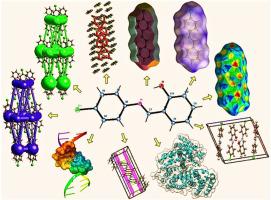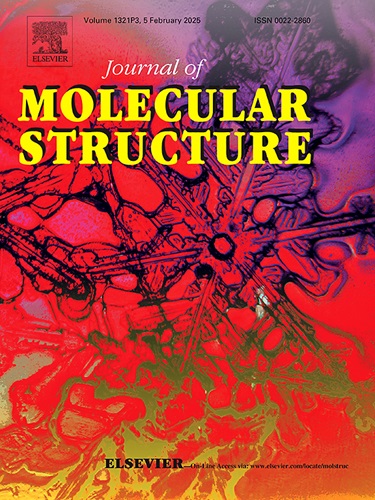Comprehensive assessment of schiff base derived from 4-Chloroaniline and 2-Formylphenol: Molecular architecture, experimental with computational bioactivity profiling, emphasizing anticancer efficacy against pulmonary and mammary carcinoma cell models
IF 4
2区 化学
Q2 CHEMISTRY, PHYSICAL
引用次数: 0
Abstract
This study thoroughly analyses the structural and biological properties of a Schiff base compound synthesized from the condensation of 2-formyl phenol and 4-chloroaniline. Single crystal X-ray diffraction examination indicated that the compound crystallizes in the monoclinic space group P21/c, with unit cell parameters a = 13.4232(15) Å, b = 5.7860(6) Å, c = 14.699(2) Å, β = 106.048(6) °, and Z = 4. The molecular structure has an E configuration around the C = N double bond, with a bond length of 1.266(2) Å, and includes an intramolecular O—H⋯N hydrogen bond. Hirshfeld surface analysis elucidated intermolecular interactions inside the crystal lattice, emphasizing dominant hydrogen-hydrogen, hydrogen-chlorine, and carbon-hydrogen contacts. The chemical exhibited concentration-dependent antioxidant and anti-inflammatory effects. Studies on DNA interactions indicate van der Waals forces between the ligand and nucleic acid, whereas it demonstrated considerable binding affinity for BSA with a ΔG value of -6.9 kcal/mol. ADME study revealed values within the recommended range, indicating advantageous pharmacokinetic characteristics. PASS filter-based cytotoxicity predictions indicated significant anti-cancer efficacy against breast adenocarcinoma, small cell lung carcinoma, and lung cancer. Toxicological assessments in diverse models indicated no possible irritation to skin and ocular tissues, highlighting its safety profile for therapeutic use. This research advances our comprehension of Schiff bases with halogen substituents and their prospective uses in chemistry and biology.

全面评估由 4-氯苯胺和 2-甲酰基苯酚衍生的片基:分子结构、实验和计算生物活性分析,强调对肺癌和乳腺癌细胞模型的抗癌功效
本研究深入分析了一种由 2-甲酰基苯酚和 4-氯苯胺缩合合成的希夫碱化合物的结构和生物特性。单晶 X 射线衍射检查表明,该化合物结晶于单斜空间群 P21/c,单胞参数 a = 13.4232(15) Å,b = 5.7860(6) Å,c = 14.699(2) Å,β = 106.048(6) °,Z = 4。分子结构围绕 C = N 双键呈 E 型构型,键长为 1.266(2) Å,并包含一个分子内 O-H⋯N 氢键。Hirshfeld 表面分析阐明了晶格内的分子间相互作用,强调了主要的氢-氢、氢-氯和碳-氢接触。这种化学物质具有浓度依赖性的抗氧化和抗炎作用。对 DNA 相互作用的研究表明,配体与核酸之间存在范德华力,而它与 BSA 的结合亲和力相当高,ΔG 值为 -6.9 kcal/mol。ADME 研究显示,其值在推荐范围内,表明其具有良好的药代动力学特性。基于 PASS 过滤器的细胞毒性预测表明,该药物对乳腺癌、小细胞肺癌和肺癌具有显著的抗癌功效。在不同模型中进行的毒理学评估表明,该化合物不会对皮肤和眼部组织产生刺激,从而突出了其治疗用途的安全性。这项研究加深了我们对带有卤素取代基的希夫碱及其在化学和生物学中的应用前景的理解。
本文章由计算机程序翻译,如有差异,请以英文原文为准。
求助全文
约1分钟内获得全文
求助全文
来源期刊

Journal of Molecular Structure
化学-物理化学
CiteScore
7.10
自引率
15.80%
发文量
2384
审稿时长
45 days
期刊介绍:
The Journal of Molecular Structure is dedicated to the publication of full-length articles and review papers, providing important new structural information on all types of chemical species including:
• Stable and unstable molecules in all types of environments (vapour, molecular beam, liquid, solution, liquid crystal, solid state, matrix-isolated, surface-absorbed etc.)
• Chemical intermediates
• Molecules in excited states
• Biological molecules
• Polymers.
The methods used may include any combination of spectroscopic and non-spectroscopic techniques, for example:
• Infrared spectroscopy (mid, far, near)
• Raman spectroscopy and non-linear Raman methods (CARS, etc.)
• Electronic absorption spectroscopy
• Optical rotatory dispersion and circular dichroism
• Fluorescence and phosphorescence techniques
• Electron spectroscopies (PES, XPS), EXAFS, etc.
• Microwave spectroscopy
• Electron diffraction
• NMR and ESR spectroscopies
• Mössbauer spectroscopy
• X-ray crystallography
• Charge Density Analyses
• Computational Studies (supplementing experimental methods)
We encourage publications combining theoretical and experimental approaches. The structural insights gained by the studies should be correlated with the properties, activity and/ or reactivity of the molecule under investigation and the relevance of this molecule and its implications should be discussed.
 求助内容:
求助内容: 应助结果提醒方式:
应助结果提醒方式:


